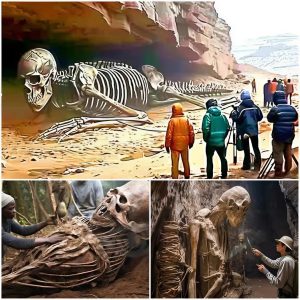In a groundbreaking archaeological find, a team of researchers has uncovered a giant horned skeleton in East Africa, sparking intrigue and excitement within the scientific community. This discovery, set against the backdrop of East Africa’s rich archaeological history, promises to shed new light on the region’s ancient mysteries and human origins.
The Discovery
The skeleton, unearthed in a remote area of the Great Rift Valley, is unlike anything previously found in the region. Measuring an astounding 12 feet in length, the skeleton features prominent horn-like structures on its skull, suggesting a creature that has not been documented in historical records. The site of the discovery, a previously unexplored cave system, has been sealed off for further investigation, drawing the attention of scientists and historians from around the world.
The Excavation Process
The excavation process was a meticulous endeavor, undertaken by a multidisciplinary team of archaeologists, paleontologists, and geologists. Dr. Emily Hughes, the lead archaeologist on the project, described the moment of discovery as “a once-in-a-lifetime experience.” The team employed advanced techniques such as ground-penetrating radar and 3D imaging to carefully extract the skeleton without causing damage. “We knew we were onto something significant when we first detected the unusual bone structure,” Dr. Hughes explained. “But seeing the complete skeleton with the horns was beyond our wildest expectations.”
Implications for Human History
The implications of this discovery are profound. The skeleton’s size and horned skull raise questions about the existence of giant humanoid creatures in ancient times. While myths and legends from various cultures have often depicted giants, this find provides tangible evidence that such beings may have existed. Dr. Samuel Patel, a renowned anthropologist, suggests that this discovery could potentially rewrite aspects of human history. “If this skeleton is indeed that of a previously unknown hominid species, it could alter our understanding of human evolution and migration patterns,” he remarked.
Theories and Speculations
The discovery has given rise to numerous theories and speculations within the scientific community. One theory posits that the skeleton could belong to a species of hominids that evolved separately from known human ancestors. Another theory suggests that the horns could be a form of defense or a mating display, similar to antlers in modern deer. However, some scientists caution against jumping to conclusions. Dr. Maria Gonzales, a skeptic of the more fantastical interpretations, emphasized the need for rigorous analysis. “We must approach this with scientific rigor and not let our imaginations run wild,” she stated. “It’s crucial to conduct thorough DNA testing and comparative analysis with other known species.”

Cultural and Mythological Connections
The discovery also has significant cultural and mythological connections. Local tribes in the area have long told stories of giant beings with horns that roamed the land in ancient times. This find has reignited interest in these oral traditions, offering a potential bridge between myth and reality. Elders from nearby communities have been invited to share their stories and insights, adding a valuable cultural dimension to the scientific investigation. “Our ancestors spoke of giants who walked the earth,” said one tribal elder. “This discovery proves that their stories were not mere legends but perhaps a part of our history.”
The Road Ahead
The next steps for the research team involve detailed analysis and preservation of the skeleton. Advanced carbon dating techniques will be employed to determine the age of the bones, while DNA extraction and sequencing could reveal more about the creature’s genetic makeup and its place in the evolutionary tree. Additionally, further exploration of the cave system may uncover more remains or artifacts that could provide context to this extraordinary find.
Conclusion
The discovery of a giant horned skeleton in East Africa is a monumental achievement that has captured the imagination of both scientists and the public. As researchers continue to unravel the mysteries surrounding this find, it has the potential to significantly impact our understanding of ancient history and human evolution. This remarkable discovery serves as a reminder of the endless wonders that our world still holds, waiting to be unearthed by those who dare to explore its depths.





